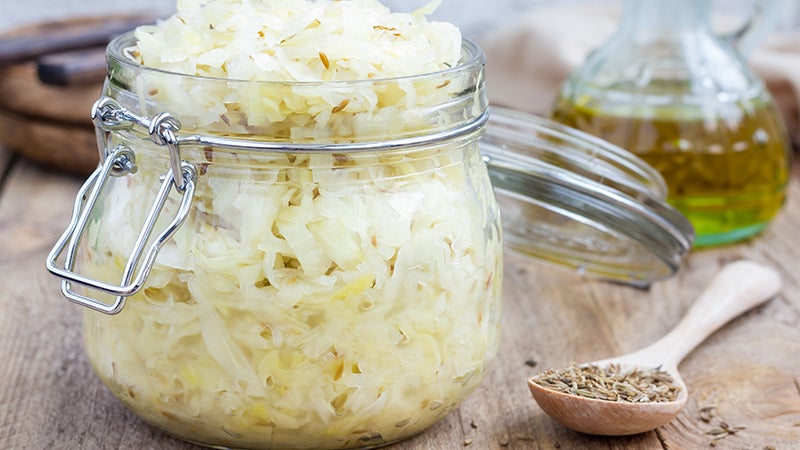Have no sour feelings about sauerkraut
Published 8:00 am Saturday, September 1, 2018
Believe it or not, winter is coming.
This is a good time to think about preserving some vegetables that you find in your cold cellar or at the fall famers market.
Of course, cabbage is a good choice, but really, that is just the beginning. Consider adding cauliflower, carrots, cucumbers, daikon radishes — just about any vegetable can be fermented.
What is fermentation? It’s the process of using microorganisms, such as bacteria or yeast, to convert carbohydrates to alcohol or organic acids under anaerobic conditions.
Fermentation is a food preservation method has a very long history, perhaps as long as 12,000 years. Cheese, yogurt, kefir, sauerkraut, kimchee, olives, salami, jerky and bread, as well as beverages such as hard cider, wine, beer and coffee, were all produced by the fermentation process.
Some fermented foods have been critical to the food culture of a country or region. Think yogurt in the Middle East, sauerkraut in Germany and fermented sausages in Italy.
There are several benefits to fermenting food.
First, fermentation serves to enhance the digestion of food. Your body needs adequate digestive enzymes to properly absorb, digest and utilize nutrients in food.
When vegetables like cabbage and cucumbers are left to steep and sit, the sugars are broken down to promote the growth of beneficial bacteria, which work as reinforcement for the good bacteria in the digestive system. Since 70 to 80 percent of the immune system lies in the gut, having proper balance of gut flora is important.
Sauerkraut is also a good source of vitamin C in the winter. Probiotic yogurt is extremely high in calcium, zinc, B vitamins and protein.
Years and years of food preservation via fermentation have resulted in the development of safe and effective methods for processing these foods. According to Dr. Fred Breidt Jr., a United States Department of Agriculture microbiologist who specializes in the safety of fermented and acidic foods, scientific literature has never recorded a case of food poisoning from raw vegetables that have been fermented properly. Please note the key word — properly!
If you would like to learn more about fermentation, call the Polk County Extension Offices at 828-894-8218. •
Jimmi Buell, extension agent, family and consumer sciences, Polk County Center of the North Carolina Cooperative Extension Service, teaches cooking and nutrition classes with a focus on improving health with better food choices. She can be reached at jimmi_buell@ncsu.edu or
828-894-8218.
SAUERKRAUT
Yield: About 9 quarts
Ingredients
25 pounds cabbage
3/4 cup canning or pickling salt
Directions
For the best sauerkraut, use firm heads of fresh cabbage. Shred cabbage and start kraut between 24 and 48 hours after harvest.
• Work with about 5 pounds of cabbage at a time. Discard outer leaves. Rinse heads under cold running water and drain.
• Cut heads in quarters and remove cores. Shred or slice to a thickness of a quarter.
• Put cabbage in a suitable fermentation container and add 3 tablespoons of salt. Mix thoroughly, using clean hands. Pack firmly until salt draws juices from cabbage.
• Repeat shredding, salting and packing until all cabbage is in the container. Be sure it is deep enough so that its rim is at least 4 or 5 inches above the cabbage. If juice does not cover cabbage, add boiled and cooled brine (1 1/2 tablespoons of salt per quart of water).
• Add plate and weights; cover container with a clean bath towel.
• Sauerkraut fermentation can take place under variable temperature and time combinations. To obtain a good quality sauerkraut at home, the USDA recommends storing at 70 to 75 degrees F while fermenting. At temperatures with that range, kraut will be fully fermented in about 3 to 4 weeks; at 60 to 65 degrees , fermentation may take 5 to 6 weeks.
• At temperatures lower than 60 degrees, kraut may not ferment. Above 75 degrees, kraut may become soft.
• If you weigh the cabbage down with a brine-filled bag, do not disturb the crock until normal fermentation is completed (when bubbling ceases). If you use jars as weight, you will have to check the kraut 2 to 3 times each week and remove scum if it forms. Fully fermented kraut may be kept tightly covered in the refrigerator for several months, or it may be canned as follows:
Hot pack – Bring kraut and liquid slowly to a boil in a large kettle, stirring frequently. Remove from heat and fill jars rather firmly with kraut and juices, leaving 1/2-inch headspace.
Raw pack – Fill jars firmly with kraut and cover with juices, leaving 1/2-inch headspace. Adjust lids and process according to the recommendations.
For our altitude (1,000 feet), process as following:
Hot pack: pints, 10 minutes; quarts, 15 minutes
Raw Pack: pints, 20 minutes; quarts, 25 minutes






